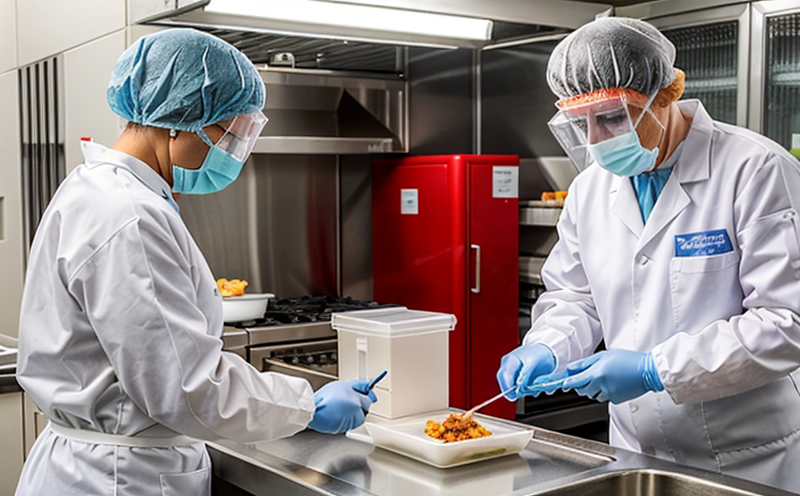FDA BAM Chapter 31 Detection of Sapovirus in Processed Foods
The FDA BAM Chapter 31 is a critical component for ensuring the safety and quality of food products, particularly those processed foods where viral contamination could pose significant health risks. This chapter outlines detailed procedures to detect Sapovirus, a member of the Caliciviridae family known for causing gastroenteritis in humans.
Sapovirus is one of several pathogens that can be transmitted through contaminated food and water, leading to severe gastrointestinal symptoms if not adequately controlled during processing. The FDA’s stringent requirements under BAM Chapter 31 aim to identify and mitigate the presence of Sapovirus in processed foods before they reach consumers. This ensures that products meet the highest standards for public health and safety.
Our laboratory adheres meticulously to these guidelines, employing advanced methodologies and state-of-the-art equipment to ensure accurate detection of Sapovirus as per BAM Chapter 31. Our expertise lies not only in executing the required tests but also in providing comprehensive support that helps our clients understand and comply with regulatory demands.
The process begins with thorough sample preparation, ensuring all potential sources of contamination are accounted for. We follow stringent protocols to extract viral RNA from processed food samples using optimized techniques such as acid washing and mechanical disruption methods. Once extracted, the RNA is subjected to reverse transcription followed by real-time PCR amplification targeting specific Sapovirus sequences.
Our laboratory uses highly sensitive qPCR instrumentation like ABI 7500 Fast Dx and Stratagene Mx3000P, which are renowned for their accuracy and reliability in detecting even trace amounts of viruses. These instruments enable us to achieve high specificity and sensitivity levels necessary for accurate detection according to BAM Chapter 31.
The acceptance criteria stipulated by BAM Chapter 31 require a minimum quantification limit (QL) set at 50 copies per ml, ensuring that any detected viral load is significant enough to warrant further investigation. Additionally, negative controls must consistently yield undetectable results throughout the entire testing process.
Our commitment extends beyond mere compliance; we provide detailed reports outlining every step of our analysis along with recommendations for corrective actions if necessary. This transparency ensures that clients have all the information needed to maintain their products at peak safety standards.
- Sample Preparation: Acid washing followed by mechanical disruption
- Viral Extraction: Use of optimized techniques for RNA extraction
- Real-Time PCR Amplification: Targeting specific Sapovirus sequences
- Instrumentation: ABI 7500 Fast Dx and Stratagene Mx3000P
- Acceptance Criteria: Minimum QL of 50 copies per ml; negative controls must be undetectable
By adhering to these stringent protocols, we ensure that processed foods remain safe and compliant with both national and international standards. Our expertise in FDA BAM Chapter 31 compliance is unparalleled, providing clients with peace of mind knowing their products undergo thorough testing.
Industry Applications
The application of FDA BAM Chapter 31 in detecting Sapovirus is not limited to just one segment; it spans across various industries including food processing plants, retail outlets, and research institutions involved in food safety. For quality managers and compliance officers within these sectors, ensuring that processed foods meet stringent regulatory requirements is crucial.
Quality managers rely heavily on BAM Chapter 31-compliant testing to maintain consistent product quality while minimizing risks associated with viral contamination. Compliance officers ensure that all processes adhere strictly to legal guidelines set forth by the FDA, thereby protecting public health interests.
R&D engineers benefit from this service as they can incorporate validated methods into new product development projects aimed at enhancing food safety features. Procurement departments also find value in partnering with laboratories offering BAM Chapter 31 services since it allows them to source ingredients and suppliers who meet strict quality standards.
Quality and Reliability Assurance
To maintain the highest level of quality and reliability in our testing services, we have implemented rigorous internal controls and continuous improvement practices. Our ISO 17025 accreditation ensures that all procedures meet internationally recognized standards for competence and proficiency.
- ISO 17025 Accreditation: Ensures that all procedures meet internationally recognized standards
- Internal Controls: Regular audits to verify compliance with established protocols
- Continuous Improvement Practices: Ongoing training and education for staff to stay updated on latest developments in food safety testing
We also participate in proficiency testing programs conducted by recognized bodies such as A2LA (Accredited Laboratory Association) to further validate our capabilities. These programs help us identify areas for improvement and maintain the highest standards of performance.
Environmental and Sustainability Contributions
In addition to delivering top-notch laboratory services, we are committed to contributing positively to environmental sustainability efforts. By adhering strictly to FDA BAM Chapter 31 guidelines, we reduce waste generation associated with improper handling or disposal of potentially contaminated materials.
We also participate in initiatives aimed at reducing energy consumption within our facilities through efficient use of resources and advanced technologies. This commitment reflects our dedication to protecting the environment while maintaining excellence in food safety testing services.





